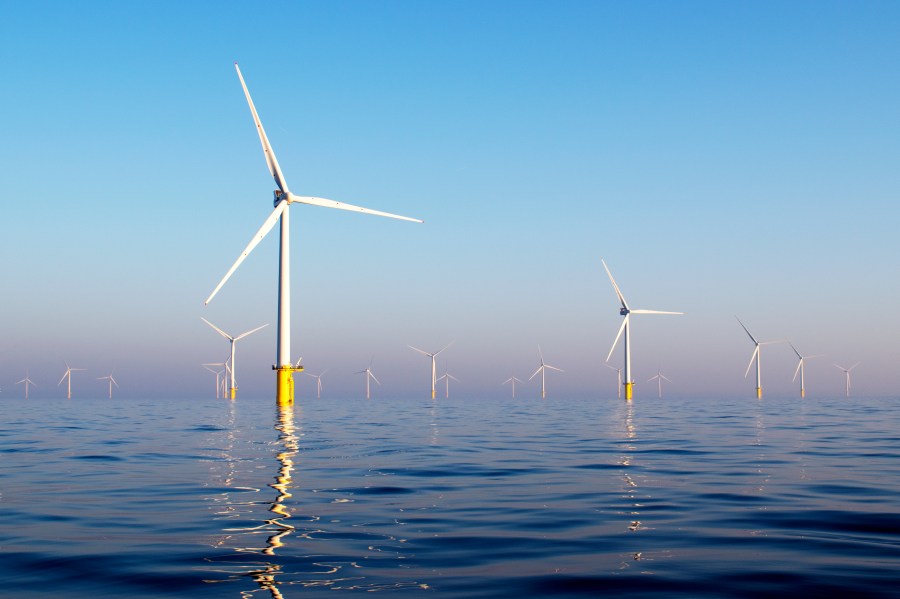They are becoming increasingly familiar off our shores and yet remain something of a mystery to many. SUSIE KEARLEY delves deep into the story of the UK’s offshore wind farms.
Along our beautiful coasts, you’ll see offshore wind turbines generating clean energy for homes and businesses across the UK. According to the Department for Business, Energy and Industrial Strategy, in 2021 the average electricity consumption for a British household was 3,898 KWh. As the population grows, our demand for power will increase too, so these turbines and offshore wind farms are an important part of our renewable energy mix.
According to RenewableUK.com there are currently 43 offshore wind farms around the British coast, comprising 2,652 wind turbines with an operational capacity of 13,660.020 megawatts. Almost 21 million homes in the UK are powered by wind, and our wind farms currently save about 34 million tonnes of CO2 emissions annually.
Britain’s first offshore wind farm was a demonstration project off the Northumberland coast. It was constructed in 2000 with two 2MW turbines less than 2km from land. They were the largest off shore wind turbines in the world at the time.
The first commercial offshore wind farm was constructed in 2003, off the coast of north Wales. It’s called North Hoyle and comprises 30 2MW turbines about 8km from shore. It was followed by a succession of other projects submitted in round one of the application process.
The last of the 12 approved projects wasn’t installed until 2013, and five of those originally submitted in round one were later withdrawn on environmental grounds. The completed round one projects now generate 1.2GW of electricity. By the end of 2003 another 15 projects had been awarded planning permission to generate a further of 7.2GW of electricity.
Next generation
In 2021, the Crown Estate allocated new areas for offshore wind farms to generate a further 8GW of electricity. ScotWind, launched in July 2021, is the Crown Estate’s project to create new wind farms in Scottish waters. One of its objectives is to create floating wind farms in the Celtic Sea, generating 4GW of electricity.
In August 2022, Hornsea 2 was the latest wind farm to go into operation, powering more than 1.4 million homes. It’s also the world’s biggest offshore wind farm.
The same month, a lease agreement was signed for Arven Offshore Wind Farm, a floating offshore site that will create employment in Scotland and the Shetland Islands, and generate 1.8GW of electricity.
The British government is committed to investing in offshore wind, with £200m allocated for projects, and an extra £24m specifically for floating offshore wind.
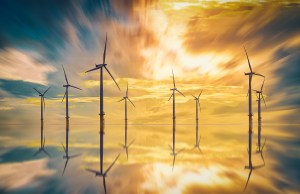
The world’s first full-scale floating wind farm went operational in 2017, called Hywind. It stands on the north coast of Scotland, in waters too deep for traditional turbines to be embedded in the seabed.
Hywind started off as a pilot project to see how successful floating turbines were, and the project ended up being the UK’s best performing offshore wind farm, year after year. Its success paved the way for the British Government to set a new target, aiming to generate 1GW of electricity from floating offshore wind turbines by 2030.
Today, Britain’s biggest floating offshore windfarm is the 50MW Kincardine offshore wind farm, 15 km off the coast of Aberdeen. It started operating in October 2021 and uses the highest capacity wind turbines ever used on floating platforms: five Vestas 9.525MW turbines and a single 2MW Vestas, which has been operating there since 2018. The farm generates around 200 GWh of electricity every year.
Bigger and bolder
The government published a British Energy Security Strategy in April 2022, with a goal to achieve up to 50GW of offshore wind by 2030. It says 5GW of this should use floating technology. This is the most ambitious plan to deliver wind energy anywhere in the world. In 2021, 25 per cent of our electricity came from wind and solar combined.
As wind farm technology improves, the size and scale of the farms is increasing. Not only are individual turbines are getting bigger, but the acreage of farms is increasing too.
The largest wind farm in the world is Hornsea 2, 89 km off the Yorkshire coast in the North Sea. It covers 462km² and has 165 8MW turbines, with capacity to generate over 1.3GW. It’s been fully operational since August 2022.
Hornsea 2 is located next to Hornsea 1, the world’s second biggest wind farm. Hornsea 1 has 174 turbines and covers 407 km². Together, these wind farms power more than 2.4 million homes.
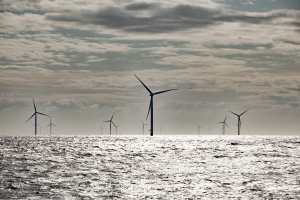
Security and threats
Most of us probably don’t think about wind farms being exposed to security risks, but in fact they are vulnerable to attack from anyone who would wish to sabotage our energy systems. When our way of life is dependent upon the power wind farms produce, we are all vulnerable to an attack.
External threats like sabotage or hacking can pose a risk to any form of energy generation. Wind farms employ security specialists to monitor the farms and mitigate the physical risks to the site’s security.
Due to their remote locations, wind farms under development are attractive to thieves who steal copper, construction equipment and other items of value. Once a site goes into operation, there is still a risk of trespass, theft and vandalism, which has to be mitigated.
Immense potential
Wave power is more expensive to implement and maintain, and therefore has been less attractive than wind power. But early wave power projects around the British coast have shown that the potential of wave power is immense. It’s actually more reliable and efficient than wind power, so it could deliver greater returns in the long run if we commit to investment in infrastructure, operations and maintenance.
Pilot projects have shown that large-scale wave energy is generally more consistent and possibly lower in cost than wind power. It’s easier to predict the energy generation capacity of waves with accuracy, and any variability in performance can be reduced by putting a wave farm across a large geographic area.
You can view a map of Britain’s offshore wind farms here: tinyurl.com/79u653cp
The key questions:
- How do the turbines work?
As the blades turn, a gearbox inside increases the rotation speed, so that inbuilt generators can convert the energy created by wind power into electricity. The electricity is then transmitted down cables to substations, where it is fed first into the regional, then the national, grid.
2. How many people work in the industry?
The number of people employed, both directly and indirectly, by the British wind industry increased steadily from 35,900 in 2013 to 82,800 in 2018. Offshore wind alone supported over 31,000 jobs in 2022 – up from 26,000 in 2021. Employment in offshore wind is expected to reach 97,000 by 2030. 61,000 of those will be employed by the industry directly, while 36,000 will be employed in sectors that support offshore wind.
3. How are wind farms regulated?
The Crown Estate manages the seabed around England, Wales, and Northern Ireland. They have the power to grant licences to companies wishing to build wind farms up to 200 nautical miles offshore, under rights provided to them by the Energy Act 2004.
Companies wishing to construct an offshore wind farm have to go through a vigorous application process, which takes into account surveys, inspections, and impact assessments on wildlife. The wind farms also have to comply with maritime safety regulations, which means most towers are designed to be tall enough for the blade to clear the water, but should be no taller than that for optimal operation and safety.
4. How much wind do the turbines need?
Strong winds are important for the good performance of wind turbines. The National Grid says: “Wind turbines can operate in anything from very light to very strong wind speeds. They generate around 80 per cent of the time, but not always at full capacity. In really high winds they shut down to prevent damage.”
An average wind speed of five metres per second (5m/s) or more is necessary for a wind farm to work effectively. An increase in average wind speed from 6 m/s to 7 m/s results in 60 per cent more power generated by the same turbine and it increases the energy production for the year by 36 per cent.
5. What do wind farms mean for ecology?
Wind farms are better for the environment than coal or natural gas, because wind energy has much lower carbon emissions. Coal-fired energy has 90 times the carbon footprint of wind energy. And natural gas has more than 40 times the footprint of wind.
Wind farm companies consult with conservation groups, such as the RSPB, Natural England, The Wildlife Trusts and The Environment Agency. Sometimes it’s necessary to route onshore cables to minimise the impact on habitats.
There is some risk to birds, however. Science Focus suggests that between 10,000 and 100,000 birds die every year in the UK after being hit by a wind turbine blade. Proponents of wind energy argue that 55 million birds are killed by people’s pet cats in the UK, making turbines a relatively small threat. However, there are things that can be done to reduce the risk to birds. A small Norwegian study suggested that painting one of the blades black reduced bird fatalities by 70 per cent.
Marine life is affected by the noise and disturbance taking place during construction, but once the construction is complete, there are benefits. In Scandinavian waters, wind farm foundations have become artificial reefs, with plants growing on the foundations and providing habitats that attract molluscs and small fish.
Larger fish, seals and dolphins benefit from these ecological systems and they’ve been described by scientists as sanctuaries because fishing is limited around wind turbine areas, making them a safe place for the fish to swim and breed.
6. How does maintenance work?
Operations and maintenance of wind farms is an ongoing job and it’s not cheap. About a quarter of the lifetime cost of an offshore wind farm is spent on ensuring the smooth operation of the site and on maintaining it, in all weathers.
So what do the operations and maintenance of a wind farm entail? There’s a lot to do. They have to organise the movement of people and equipment out to sea, including vessels, offshore bases, helicopters, and jack-up rigs. There’s warehousing and office space on shore for administration, tools, and the monitoring of performance.
The maintenance team undertake regular turbine inspections to ensure any problems are spotted and dealt with before they become serious issues. Regular inspections and maintenance of the foundation blocks, the cables, and the grid connectivity are important. The seabed location means inspections and maintenance can be more complicated than they would be on land and more maintenance may be needed.
7. Who gets the power?
During peak periods in energy usage, when the UK is generating a surplus to its own needs, we export electricity to Europe. A report by Drax Electric Insights says that in the second quarter of 2022 we exported substantially more than usual, some 5.5TWh of power, worth approximately £1.5 billion. That makes the UK a net exporter of electricity.
Until recently, we’d been importing more power than we’ve exported, but times are changing. During peak periods of usage in the UK, we still import electricity because it’s hard to store large volumes of electricity, so the power is used as it’s produced as much as possible.
Farms in focus
Scroby Sands
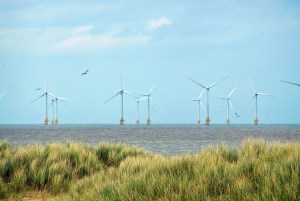
The Scroby Sands Offshore Wind Farm in Great Yarmouth was one of Britain’s first major offshore wind farms. It started operating in 2004 and stands on the Scroby Sands sandbank 2.5 km off the coast. It has 30 2MW wind turbines and can produce 60MW of electricity; enough power to supply around 40,000 homes.
The sandbank on which the turbines stand moves up to three metres a day, so the project was always going to be challenging. Some 200 people were involved in installing the four-metre diameter monopiles (steel tube) foundations, which were hammered 30m deep under the sea floor, using a hydraulic ram.
Dudgeon
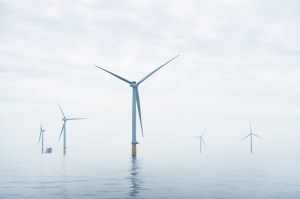
Dudgeon in Norfolk is a relatively new wind farm – it was completed in late 2017, and it currently has 67 wind turbines (6 MW). It creates enough electricity for over 410,000 homes, and is 32km off the coast.
Because of its distance from the mainland, it’s not practical for the maintenance crew to travel to the wind farm on a daily basis, so they’ve been using the Esvagt Njord service operations vessel to provide living accommodation at the wind farm for maintenance technicians.
Pay a visit!
Did you know you can take a boat tour to see the new Rampion Wind Farm off the coast of Brighton? This wind farm creates enough electricity to power around 350,000 homes. It has 116 turbines 20km off the Sussex coast.
Rampion Wind Farm also has a modern visitor centre, where the whole family can learn more about wind power and go on a virtual tour of the wind farm using virtual reality headsets.
See here for more details: rampionoffshorewindfarm.co.uk.

